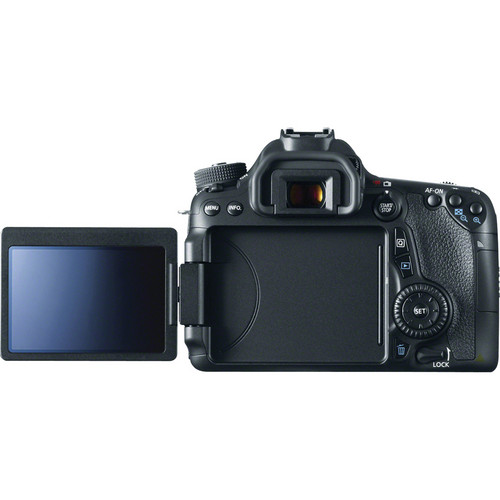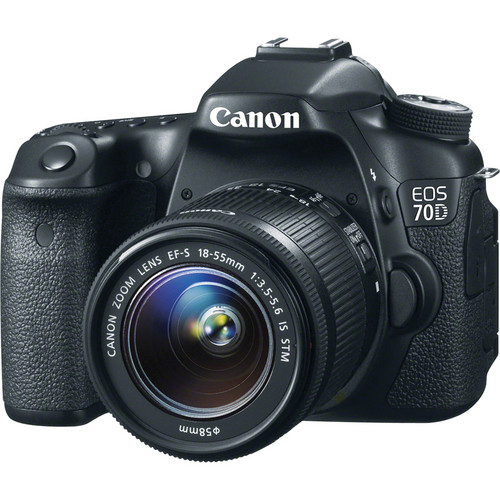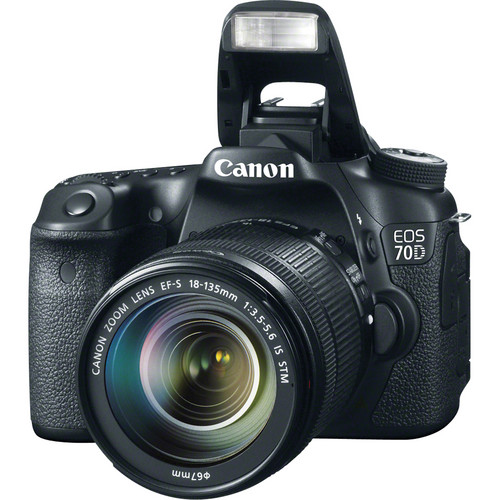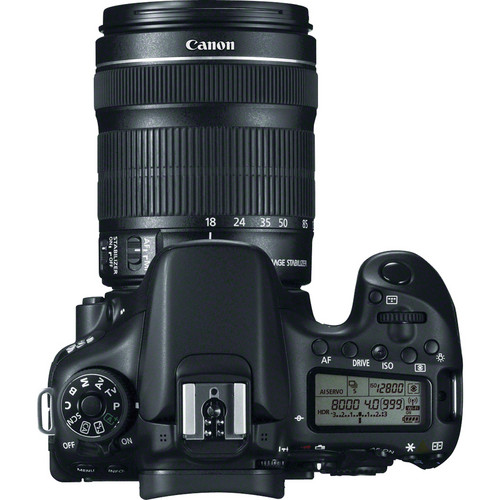
Canon EOS 70D DSLR Camera (Adorama)

Canon EOS 70D DSLR Camera with 18-55mm f/3.5-5.6 Lens (Adorama)

Canon EOS 70D DSLR Camera with 18-135mm f/3.5-5.6 Lens (Adorama)

Canon EOS 70D DSLR Camera with 18-135mm f/3.5-5.6 Lens Top View

Canon BG-E14 Battery Grip for EOS 70D
Canon Introduces The New And Powerful EOS 70D Digital SLR Camera Featuring Instant And Accurate Focusing Of Still Images And Video
Designed to Change the Way Photographers Capture Images and Video, New Camera Features Newly-Developed Dual Pixel CMOS AF Technology, Built-in Wireless Capability, 20.2 Megapixel CMOS Sensor, DIGIC 5+ Image Processor, and More
MELVILLE, N.Y., July 2, 2013 – Canon U.S.A., Inc., a leader in digital imaging solutions, is proud to introduce the high-performance EOS 70D Digital SLR camera - bringing advanced features to photo enthusiasts looking for a step up from their entry-level digital SLRs. Featuring an innovative new Dual Pixel CMOS AF system for instant and precise focusing of video as well as still images, the EOS 70D also provides outstanding image quality and performance thanks to its new 20.2 megapixel APS-C Canon CMOS sensor and Canon's superb DIGIC 5+ Image Processor.
Canon's newly-developed Dual Pixel CMOS AF, a phase-detection autofocus (AF) technology on the camera's image sensor plane, enables users to shoot video with the new EOS 70D close to the quality of a video shot with a camcorder. Dual Pixel CMOS AF employs a revolutionary CMOS sensor on which all of the effective pixels are able to perform both still imaging and phase-detection AF simultaneously to achieve dramatically improved AF performance over other EOS cameras during Live View shooting and when shooting video.
Compared with Canon's conventional Live View AF systems, Dual Pixel CMOS AF realizes shorter focusing times, exceptional tracking performance and smoother autofocusing during video shooting. And, because Live View shooting can be used in a manner similar to using the camera's viewfinder, the fast and smooth AF performance allows users to concentrate more attention on the subject and composing the photo when shooting. Dual Pixel CMOS AF also supports 1031 models of EF lenses (including many earlier models), enhancing a photographer's creative options as well as maximizing the benefit of Dual Pixel CMOS AF in a variety of situations.
"The new EOS 70D Digital SLR camera is a game-changing DSLR model that incorporates advanced features for high-quality still and video capture and intuitive operation that allows photographers to evolve their creative vision from shooting still images to shooting moving images," said Yuichi Ishizuka, executive vice president and general manager, Imaging Technologies & Communications Group, Canon U.S.A. "This camera's outstanding image quality combined with built-in wireless technology and popular creative functions and filters makes it easy to turn photos into works of art and share them immediately."
Wireless Connectivity
The EOS 70D Digital SLR camera's built-in wireless transmitter offers users several connectivity options to easily share their images. With the download of the free EOS Remote app2 from the Apple App Store or the Google Play store, users can connect to both iOS® or Android™smartphones and tablets3 to wirelessly transfer photos and videos from their camera to their device. They can also control aperture, shutter speed, and ISO from their smartphone. This camera also has the ability to connect directly to Canon's iMAGE GATEWAY4, making photos easily accessible and ready to share on social networking sites. In addition, the EOS 70D has the ability to connect wirelessly to computers, DLNA devices, Wi-Fi Certified® Canon cameras and wireless PictBridge5 compatible printers, such as the PIXMA MG6320 Wireless Photo All-In-One printer model.
Superb Still Performance
Featuring a new 20.2 megapixel APS-C Canon CMOS sensor and Canon's superb DIGIC 5+ Image Processor, as well as an extensive ISO range of 100-12800 (expandable to 25,600), the EOS 70D Digital SLR camera is capable of producing sharp, detailed images, even in low-light conditions. And with high-speed continuous shooting of up to 7.0 frames per second (fps) united with a 19-point all cross-type AF system (including a high-precision f/2.8 dual cross-type AF center point), it allows photographers to easily capture accurately focused fast moving subjects. In addition, the camera's Scene Intelligent Auto Mode delivers optimized photos and offers outstanding scene detection for amazing results even when shooting in low light.
The EOS 70D also incorporates a 63-zone Dual Layer IFCL (Intelligent Focus, Color & Luminance) AE metering system which enhances accurate exposures by minimizing random metering errors caused by varying subject colors and light sources. Other useful features include a built-in Electronic Level Function, Manual WB settings and AF Microadjustment.
Enhanced EOS Full HD Movie Mode for Professional Quality Video
With Canon's new Dual Pixel CMOS AF system and Movie Servo AF, the camera provides continuous phase-detection AF during video recording for quick and accurate focus tracking of moving subjects in the central 80 percent of the imaging area. While shooting with any of Canon's Stepping Motor (STM) lenses, such as the new EF-S 18-55mm f/3.5-5.6 IS STM lens, motor noise from the lens is significantly reduced so the camera will only capture the stereo sound of the scene being recorded. For added flexibility, the EOS 70D Digital SLR camera also features a built-in stereo microphone with manual audio level adjustment and an attenuator function to reduce audio clipping, an accessory jack for external stereo microphones and Video Snapshot mode with editing for expanded video shooting options. When users select the EOS Movie Mode, the EOS 70D offers the ability to shoot in 1080p Full HD video up to 30 fps in either ALL-I or IPB codecs with optional embedded time code, matching the flexibility of other current EOS cameras such as the EOS-1D X, EOS 5D Mark III, and EOS 6D models.
Expanding Creativity
The EOS 70D Digital SLR camera provides advanced amateur photographers and photo hobbyists looking to hone their creative and technical skills with an innovative range of in-camera imaging features such as High Dynamic Range, Multiple Exposure, Handheld Night Scene and HDR Backlight Control modes that allow for expanded creativity. The new camera is also equipped with built-in RAW Image Processing and Image Resizing functions.
When any one of the seven Creative Filters is applied in Live View, users can preview the effect of the filter on the three-inch Vari-Angle Touch Screen monitor without having to shoot the image first. Users can pick from effects such as Art Bold, Fish-eye, Water-painting, Grainy Black and White, Soft Focus, Toy Camera and Miniature and choose the one that best expresses their creative vision before or after the image is captured.
All of these features, when combined with a high-resolution Vari-angle Touch Screen 3.0-inch Clear View LCD monitor II with intuitive touch controls featuring multi-touch operation and Touch AF, make it the ideal camera choice for photographers looking for the best in imaging technology.
The EOS 70D is compatible with the full line of Canon EF and EF-S lenses as well as SD/SDHC/SDXC memory cards, including Ultra High Speed (UHS-1) cards.
Availability
The EOS 70D Digital SLR camera is scheduled to be available in September 2013 for an estimated retail price of $1199.00 for the body alone and $1349.00 bundled with an EF-S 18-55mm f/3.5-5.6 IS STM lens or $1549.00 bundled with the EF-S 18-135mm f/3.5-5.6 IS STM lens. Also available will be a new Battery Grip BG-E14 that conveniently accepts up to two LP-E6 battery packs or a set of six AA batteries for an estimated retail price of $270.00.
Ron’s Take
I loved the 40D and it and the cameras that came before it represented a good middle ground between the Rebel and the more expensive pro cameras, but the 50D and up disappointed me. They felt more like more expensive Rebels in a different body. I’m glad to see that the 70D adds some of the features that you’d find in a 6D and it seems to be a proper step up from the Rebel again. With that said, I’m quite familiar with phase detection cameras from Fujifilm and the Nikon V1, and honestly I hate phase detection focus. Fujifilm finally got things right with the x100s as it has a system that uses BOTH phase detection and contrast detection for the best of both worlds, so I’m scratching my head as to why Canon didn’t go this route. Phase detection might give better video focus performance, but this is a DSLR so that means nothing if the indoor low light focusing sucks like I’ve experienced with other phase detection only cameras like the X100, X-Pro1, etc…
Personally I’m wondering if cropped sensor DSLR’s still make much sense anymore given the quality that we are seeing with mirrorless cameras these days. There’s lots to like on paper about this camera, but I can’t help but think that if you are going to go with a bulky DSLR then you ought to get the benefit of a full-frame sensor so the 6D or D600 seems to be the better choice for the best image quality. With that said, I haven’t used one of these yet so I’ll have to see if this ends up being a surprise performer like the Nikon D7100, or if is yet another disappointing release in the xxD series.
Where to order
Please use the links in the article above to pre-order now.
Other articles you may enjoy
If you enjoyed this article, you may also enjoy these:
- Canon 5D Mark III First Look (For Parents Version)
- Canon 6D (vs Canon 5DM3 & D600)
- Canon 600EX-RT Flash First Look (ST-E3 RT)
- Canon 40mm f/2.8 STM Pancake Lens
- Canon 8-15mm f/4L Fisheye Zoom
- Canon 24-70 f/2.8L II (vs 24-70 f/4L IS Comparison)
- Canon 70-200mm f/2.8L IS II USM First Look
- Canon 70-300mm f/4-5.6L IS vs 70-300 f/4.5-5.6 DO
- Canon G12 vs S95
- Canon G1X vs G12 vs Fujifilm X10
- Canon G15 vs s110 vs G12
- Canon Rebel T5i/700D
- Canon EOS M
- Nikon D7100 - A Mini D800?
- Nikon D600 (vs Canon 5DM3 & 6D)
- Nikon D800
- Which camera should I buy?
- Things You Need AFTER You Buy Your New Camera - Must Have Photography Accessories
Disclosure
If you make a purchase using links found in this article, I may make a commission. It doesn’t cost you a penny more, but it does help to support future articles like this.

5 comments:
Hi Ron great site you have, right now I have the 5D III (great camera btw) with 5 L lenses but really need a back up camera as I have a wedding to shoot in September and sold my 5D II to purchase the 5D III, and since the 70D will be available in September and I do not like to buy a camera until I see the reviews, I actually found a 40D with grip for 350.00 and is in great condition, I am mainly a landscape/nature photographer but do weddings on the side for extra money, I kind of wanted a crop camera for like BIF what do you think? thanks
Chris;)
Chris,
I really need to test this one to see if it is another disappointment like the 50D & 60D. I'm also very concerned about the focus performance as a DSLR camera (video should be much improved).
Until I use the 70D, my advice is still that the 6D is the best camera to complement your 5DM3 (and the 6D image quality will surpass it).
I do hope/expect it to have an improved image quality over the 60D/7D, so in theory that should be a big plus but my experience with phase detection AF systems makes me nervous to recommend this just yet.
You don't think that I will be disappointed with the lower specs of the 6D? actually Ron I was born in Vancouver BC but grew up in Marysville washington since age 2, but now live in Greece and I do come back to Seattle every year which I was thinking of buying the 1Dx when I get back but it is kind of expensive so not sure, and crop camera well I have been spoiled with FF IQ, btw thanks for getting back;)
Chris,
I own a 1D-X and a 5D Mark III and when I reviewed the 6D I felt stupid for buying my 5D Mark III because the 6D has 1D-X image quality with what is effectively a 60D body. While I appreciate the 5D Mark III's AF system and features, the reality is that the 6D is much of what I was used to with my 5D Mark II which served me well. When I put the snob factor aside and looked at it objectively, the 6D makes a lot more sense for me than the 5D Mark III. If I hadn't paid full MSRP for the 5DM3 or I could have returned it, I would have as the 1D-X gives me everything I need so the 6D is the better second camera.
Some people spend too much time looking at stats on paper and not using the darn products.
The user controls of the 6D will frustrate you a little bit and you'll miss the 5D Mark III AF, but when you see the IQ of the 6D you won't be disappointed. As a 1D-X owner I consider the images to be identical to what I have on my 1D-X.
Greece & Seattle - you must have a good portfolio as those are great places to live so you can take amazing photos! ;-)
Thanks again Ron, I will probably get the 6D to complement my 5D III and when I come back to the States I will look at the 1Dx, if you want you can take a look at my site
www.chrisksphotography.com
Thanks again
Chris;)
Post a Comment